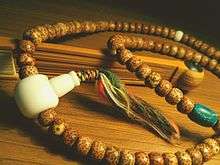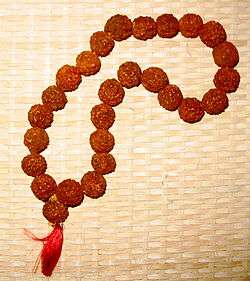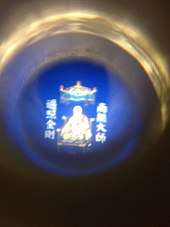Japamala
A Japamala or mala (Sanskrit:माला; mālā, meaning 'garland'[1]) is a string of prayer beads commonly used in Hinduism, Jainism, Sikhism, Buddhism and Shintō for the spiritual practice known in Sanskrit as japa. They are similar to other forms of prayer beads used in various world religions and sometimes referred to in English as a "rosary".
| Japamala | |||||||||||||||||||||||
|---|---|---|---|---|---|---|---|---|---|---|---|---|---|---|---|---|---|---|---|---|---|---|---|
_of_Tulasi_wood_with_108_beads_-_20040101-01.jpg) Japa mala, made from tulasi wood, with head bead in foreground. | |||||||||||||||||||||||
| Chinese name | |||||||||||||||||||||||
| Chinese | 佛珠 | ||||||||||||||||||||||
| Literal meaning | "Buddha pearls" | ||||||||||||||||||||||
| |||||||||||||||||||||||
| Japanese name | |||||||||||||||||||||||
| Kanji | 念珠, 数珠 | ||||||||||||||||||||||
| |||||||||||||||||||||||
| Sanskrit name | |||||||||||||||||||||||
| Sanskrit | mālā (माला) | ||||||||||||||||||||||
The main body of a mala is usually 108 beads, though other numbers are also used. In addition, there is often a 109th bead (often of a distinctive size or colour) and/or tassle and sometimes there are additional beads which may be decorative or used for counting rounds. Malas are used for keeping count while reciting, chanting, or mentally repeating a mantra or the name or names of a deity.
History
The specific origin of the mala is unknown, with the use of beads for counting being a widespread practice in ancient cultures.[2] No references to malas occur in Chinese literature before the introduction of Buddhism during the Han dynasty, suggesting that the practice spread from India to China and may have originated there.[2] No mention of a mala occurs in the Agamas or Pali Nikayas, generally regarded as the oldest Buddhist literature, and it is unclear if their use originated with Buddhists or with Brahmins, Jains, or another Indian religious community.[2] Malas may appear in early Brahmanic/Hindu art as part of the garb of deities or worshippers, but are difficult to distinguish from decorative necklaces or garlands. The earliest clear depiction of a mala being used as a tool for recitation, rather than possibly being a necklace or decoration, comes from a bodhisattva image created during the 4th-6th Century Northern Wei dynasty in China- the mala is being held in the hand, rather than worn.[2]
The first literary reference to the use of a mala for the recitation of mantras comes from the Mu Huanzi Jing (木槵子經 or 佛說木槵子經, "Aristaka/Soap-Berry Seed Scripture/Classic", Taishō Tripiṭaka vol. 17, no. 786), a Mahayana text purported to have been translated into Chinese during the Eastern Jin era, some time in the 4th - 5th Century CE.[2] No mention of this text occurs in standard bibliographies before the 6th Century, but an independent translation in the 8th Century suggests an origin as a Sanskrit text transmitted from Central Asia, rather than a Chinese composition.[2] According to this text, the Buddha instructed a king to make a mala from the seeds of the aristaka plant and recite the Triratana while passing the mala through his fingers in order to calm his mind and relieve his anxiety.[2]
While the earliest Buddhist story about the mala is associated with lay practice, in China it was initially primarily associated with monastic practice.[2] Images of monks with malas began to appear in China in the 7th Century CE and the mala seems to have been regarded as a common piece of monastic equipment by around this era.[2] While there are relatively few pre-Song Dynasty depictions or references to the mala, this may be due to its use in private religious practice rather than public ceremony.[2] Chinese authors criticized monks who recited mantras on their malas in public, as monks were generally expected to remain silent while on public alms rounds.[2]
By the Ming Dynasty-era, malas increasingly began to be valued for their aesthetic qualities as much or more than their spiritual use.[2] Malas of expensive or rare materials became common as gifts given among the wealthy, and the materials allowed to different grades of wives and concubines was regulated by sumptuary laws.[2] Depictions of Qing Dynasty court officials often include malas, intended to show their status and wealth rather than as an indication of spirituality.[2]
Usage


Mantras are typically repeated hundreds or even thousands of times. The mala is used so that one can focus on the meaning or sound of the mantra rather than counting its repetitions.[3]
There are numerous explanations why there are 108 beads, with the number 108 bearing special religious significance in a number of Hindu, Buddhist and Jain traditions.[2] For example, in traditional Buddhist thought, people are said to have 108 afflictions or kleshas.[4] In another reckoning, 108 is the number of possible dharmas or phenomena.[2] Despite the varying explanations for the use of this number, the number itself has been kept consistent over centuries of practice.[2] Smaller malas, most commonly with 54 or 27 beads, are also known, and may be worn on the wrist or used to more conveniently keep count of prostrations.[2]
The 109th bead on a mala is called the sumeru, bindu, stupa, guru bead, or mother bead, and is sometimes larger or of a distinctive material or color.[2] Counting begins with a bead next to the mother bead. In the Hindu tradition and some Buddhist traditions, if more than one mala of repetitions is to be done, one changes directions when reaching the mother bead rather than crossing it.[2] In some Buddhist traditions, the mother bead represents Amitabha or Avalokitesvara.[2]
In addition to their practical use as an aide in recitation, malas have traditionally been imbued with additional spiritual qualities.[2] Different materials may be ascribed the power to help with different practical or spiritual problems, and the mala itself may be ascribed talismanic characteristics.[2] In some traditions, malas are consecrated before use in a manner similar to images of deities, through the use of mantras, dharani, or the application of pigment.[2] Popular folk tales may describe malas as 'storing' the power of many recitations, or a mala given by a respected monk having the power to cure illnesses or restore fertility to barren individuals.[2]
Counting beads
On Buddhist mala additional beads may hang from a pair of short cords. On Chinese Buddhist mala there are often three beads on each cord and the cords are just the end of the string used for the rest of the mala. These beads are often decorative, being unable to move because of how the cords are tied.[2]
On a Tibetan Buddhist mala there are often ten beads on each cord and the cords can be attached to the main string anywhere. These extra beads are often smaller than the normal size beads and the holes in them are smaller, or a thicker cord is used to prevent these smaller beads from sliding freely. One of these cords is decorated with a small bell and the other with a small dorje. When a complete round is completed on the mala, one small bead, say on the dorje cord, is slid up. When after ten rounds all the beads on the dorje cord are slid up (representing 1000 recitations; although there are 108 beads each round is counted as only 100 recitations to allow for imperfect recitations), they are returned to their starting position and one bead on the bell cord is slid up. In this manner 10,000 (or more) recitations can easily be counted.
For a mala without counting beads, it is possible to add a single cord woven as a pair tassles each holding the counting beads to any mala. This adds the convenience that the extra cord can be slid along the mala to record position if the recitation is interrupted.
Counting beads may also refer to a differently coloured bead or a bead made of different material than normally occurs on the main string. These counting beads may replace the normal beads or they may be in addition to the normal beads and exist only as markers to indicate position. For example, a mala made of wooden beads may have three extra stone beads added, one after each of the 27th, 54th and 81st wooden beads (meaning these three counting beads and the guru bead divide the mala into quarters). Such a mala would have 112 beads (108 normal beads, 1 guru bead, 3 counting beads) but only the 108 normal beads would be used.
Materials

| Wikimedia Commons has media related to Rudraksha. |

A wide variety of materials are used to make mala beads. Beads made from the seeds of the rudraksha tree are considered sacred by Saivas, devotees of Siva, while beads made from the wood of the tulsi plant are used and revered by Vaishnavas, followers of Vishnu.[5]
Another general-purpose mala is made from rattan seeds;[6] the beads themselves called "moon and stars" by Tibetans, and variously called "lotus root", "lotus seed" and "linden nut" by various retailers. The bead itself is very hard and dense, ivory-coloured (which gradually turns a deep golden brown with long use), and has small holes (moons) and tiny black dots (stars) covering its surface.
Other common beads include wood or seeds from the sandalwood tree or the Bodhi tree, and seeds of the Lotus plant. Some Tibetan Buddhist traditions call for the use of animal bone (most commonly yak), those of past Lamas being the most valuable. Semiprecious stones such as carnelian and amethyst may be used, as well. In Hindu Tantra, as well as Buddhist Tantra (or Vajrayana), materials and colors of the beads can relate to a specific practice, such as in Hinduism, red and black hakik for taamsik sadhna sphatik or quartz for praying any god, red moonga stone mainly for praising.[7]
In Nepal, mala beads are made from the natural seeds from the Buddha chitta plant, Ziziphus budhensis, a plant in the family Rhamnaceae endemic to the Timal region of Kavreplanchok in Central Nepal.[8] The Government of Nepal's Ministry of Forestry has established a committee and begun to distribute seedlings of these plant so as to uplift the economic status of the people living in this area.[9][8]
Traditions
Japanese Buddhism

In Buddhism in Japan, Buddhist prayer beads are known as ojuzu (数珠, counting beads) or onenju (念珠, thought beads), where the "o" is the honorific o-. Different Buddhist sects in Japan have different shaped juzus, and use them differently. For example, Shingon Buddhism, Tendai and Nichiren Buddhism may use longer prayer beads with strands on both ends similar to those used in mainland Asia. During devotional services, these beads may be rubbed together with both hands to create a soft grinding noise, which is considered to have a purifying effect. However, in Jōdo Shinshū, prayer beads are typically shorter and held draped over both hands and are not ground together.
Jōdo-shū is somewhat unusual because of the use of a double-ringed prayer beads, called nikka juzu (日課数珠), which are used for counting nenbutsu recitations (i.e. recitation of the name of Amitabha Buddha): one ring contains single beads used to count a single recitation while the other ring is used to count full revolutions of the first ring. Additionally, other beads hang from the strings, which can count full revolutions of the second ring (flat beads), or full revolutions of the first string of beads. In all, it is possible to count up to 120,000 recitations using these beads. The design is credited to a follower of Hōnen named Awanosuke.[10]

Regardless of Buddhist sect, prayer beads used by lay followers are frequently smaller, featuring a factor of 108 beads. Some beads are made using plastic, while others may contain wood, or seeds from trees in India, such as Ficus religiosa, the same species as the Bodhi Tree.
It is common to find prayer beads in Japan that contain a small image inside the largest bead, usually something associated with the particular temple or sect. When held up to the light the image is clearly visible.
Myanma Buddhism
Theravada Buddhists in Myanmar use prayer beads called seik badi (စိပ်ပုတီး [seɪʔ bədí]), shortened to badi. 108 beads are strung on a garland, with the beads typically made of fragrant wood like sandalwood, and series of brightly coloured strings at the end of the garland.[11] It is commonly used in samatha meditation, to keep track of the number of mantras chanted during meditation.[11]
Aesthetic usage
In recent years, it has become common for non-religious individuals to wear such beads as a fashion accessory, with the beads having no religious connotation whatsoever.[12] Similar practices have been noted since the Ming Dynasty, when malas began to be used as fashionable accessories by members of the Chinese court.[2] Sumptuary laws regulated the materials of malas in Qing Dynasty-era China.[2]
See also
- Prayer beads
- Buddha chitta mala
- Hindu prayer beads
- Phuang malai
- Rudraksha
- Tasbeeh
- Misbaha
- Other malas
- Mantras
- Namokar Mantra
- Aum Namah Shivaya
- Om mani padme hum
- Tantra
- Related concepts
Notes
- Apte 1965, p. 758.
- Kieschnick, John (2003). The Impact of Buddhism on Chinese Material Culture. Princeton and Oxford: Princeton University Press. pp. 118–38. ISBN 0691096767.
- "How to Use a Mala (5 Ways)". Japa Mala Beads. Retrieved 2019-11-16.
- Buswell, Robert Jr; Lopez, Donald S. Jr., eds. (2013). Princeton Dictionary of Buddhism. Princeton, NJ: Princeton University Press. p. 520. ISBN 9780691157863.CS1 maint: ref=harv (link)
- Simoons, Frederick J. (1998). Plants of life, plants of death. Univ of Wisconsin Press. pp. 7–40. ISBN 978-0-299-15904-7.
- http://www.botanicalbeads.com/BBB_page_99.html
- Buddha Dharma Education Association and Buddhanet.com Buddhist studies: Malas (beads) Retrieved 2009-02-05
- "Ziziphus budhensis Bhattarai & M.L.Pathak". IPNI . Retrieved 2015-10-31.
- Chaudhary, Sanjib (2015-08-06). "Buddha’s Beads Fetch Millions for Farmers in Central Nepal". Global Voices. Retrieved 2015-11-03.
- Watts, Jonathan; Tomatsu, Yoshiharu (2005). Traversing the Pure Land Path: A Lifetime of Encounters with Honen Shonin. Jodo Shu Press. ISBN 488363342X.
- http://www.usamyanmar.net/Buddha/Article/Praying%20beads1.pdf
- "Baidupedia article".
References
- Apte, V.S. (1965), The Practical Sanskrit Dictionary (Fourth revised and enlarged ed.), Delhi: Motilal Banarsidass Publishers, ISBN 81-208-0567-4
Additional Reading
- Dubin, L.S. (2009). Prayer Beads. In C. Kenney (Ed.), The History of Beads: From 100,000 B.C. to the Present (Revised and Expanded Edition) (pp. 79–92). New York: Abrams Publishing.
- Henry, G., & Marriott, S. (2008). Beads of Faith: Pathways to Meditation and Spirituality Using Rosaries, Prayer Beads and Sacred Words. Fons Vitae Publishing.
- Untracht, O. (2008). Rosaries of India. In H. Whelchel (Ed.), Traditional Jewelry of India (pp. 69–73). New York: Thames & Hudson, Inc.
- Wiley, E., & Shannon, M.O. (2002). A String and a Prayer: How to Make and Use Prayer Beads. Red Wheel/Weiser, LLC.
External links
| Wikimedia Commons has media related to Hindu prayer beads. |